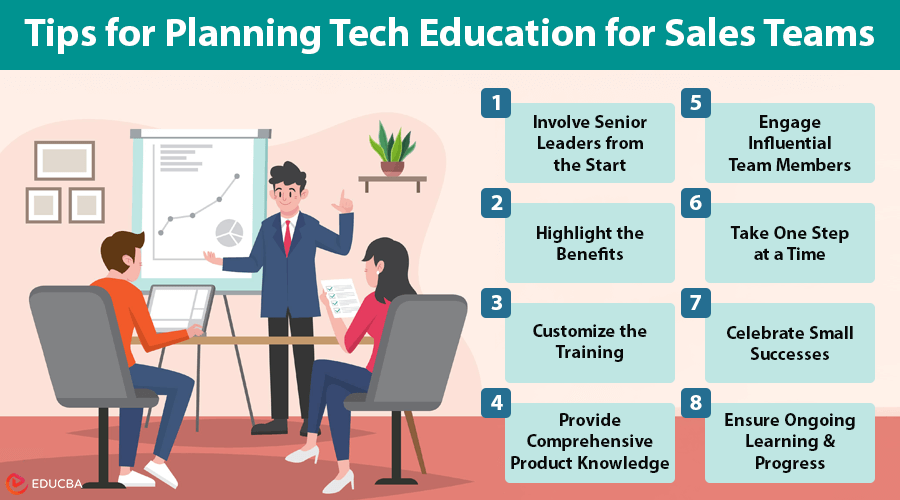
Introduction to Tech Education for Sales Teams
When implementing new technology in your sales department, there are many opportunities to explore. As more advanced sales tools emerge, 2025 will bring faster and more dynamic sales teams. Proper tech education for sales teams can increase productivity, quicker and more nuanced deals, and a streamlined, automated contract renewal process. This means fewer manual follow-ups and no missed opportunities, ultimately boosting revenue.
However, to unlock this potential, your sales reps must learn to use the new tech stack introduced. Ensuring they adopt these tools can be a challenge for sales leaders. If sales teams are already struggling with their current technologies, adding another tool might not be well-received. So, how can effective training help sales leaders bridge this gap? Let us explore.
8 Tips for Planning Tech Education for Sales Teams
Here are eight practical tips for tech education for sales teams:
#1. Involve Senior Leaders from the Start
It is crucial to have a senior leader involved from the beginning. This could be a sales manager responsible for selecting and implementing the new technology. Their guidance can help the sales team see the value in the new tools.
The senior leader should clearly define goals and explain how the technology will benefit them. To ensure everyone is aligned, they must also communicate expectations to the sales and related teams, such as marketing and customer success. By becoming early adopters of technology, leaders set an example and emphasize its necessity.
#2. Highlight the Benefits
When introducing new technology, it is important to explain why the sales team should use it and how it will help them in their daily tasks. Show how the technology will benefit the organization and the individual sales representatives.
Sales professionals must understand how the new tools will help them achieve their targets, make more money, or reduce their workload. Addressing their concerns and emphasizing the benefits can motivate them to adopt the new technology.
#3. Customize the Training
Recognize that not every sales team member will feel comfortable using new technology, and they may have varying levels of experience. Tailor the training to accommodate these differences.
Consider different learning preferences; some prefer online sessions, while others benefit from one-on-one training. Use Learning Management Systems(LMS) to facilitate online education and track progress. Using videos, interactive quizzes, and simulations can make the learning experience more engaging and accommodate different learning styles. Ensure the training covers how the new tool integrates with the existing sales process to help reps meet their goals.
#4. Provide Comprehensive Product Knowledge
Sales teams must understand its features to make the most of the new technology. This is where product knowledge training comes into play, enabling them to make informed decisions.
Sales leaders can enhance this training with product tours—interactive tutorials that show how the tool works. These tours help reps grasp buyer needs and journeys, allowing them to respond more effectively. Additionally, providing product roadmaps that outline short- and long-term goals can help educate sales reps about the tool’s features and updates.
#5. Engage Influential Team Members
To promote early adoption of the new technology, identify a group of tech-savvy and top-performing sales reps to champion the cause. These influencers can share their positive experiences and motivate others to follow suit.
Their enthusiasm can help generate momentum within the sales team, encouraging widespread adoption of the new tools.
#6. Take One Step at a Time
When rolling out new technology, it is important not to rush. Take a step-by-step approach to identify any challenges early on. This method allows sales leaders to learn from obstacles and adjust their strategies for a successful large-scale implementation.
#7. Celebrate Small Successes
Once your sales teams use the new technology, acknowledge the positive outcomes. Highlight success stories to inspire other team members to adopt the tool.
Avoid focusing solely on sales figures; humanizing the initiative can be more effective. Mention specific team members by name and share how they successfully used the new tool to achieve a goal or close a deal.
#8. Ensure Ongoing Learning and Progress
Monitoring your sales teams’ progress is vital to ensure the long-term effectiveness of tech education for sales teams. Regularly assess their knowledge and performance and adjust the training plan as needed.
Provide support and additional training opportunities to encourage ongoing development. Acknowledging and rewarding progress motivates your teams and encourages them to use their new skills in real-life situations.
Final Thoughts
A well-trained sales team can significantly enhance performance and help meet business revenue targets. As companies invest in advanced sales technologies, prioritizing tech education for sales teams is essential for maximizing these tools’ value. By implementing these tips, you can set your sales teams up for a successful transition into 2025 and beyond.
Frequently Asked Questions (FAQs)
Q1. Why will sales teams need tech education in 2025?
Answer: Tech education will help sales teams use advanced tools, predict trends, and address the challenges tech-savvy customers face.
Q2. How can I identify the right tech skills for my sales teams?
Answer: Review your current tools, then identify upcoming industry trends and the skills needed for improved performance.
Q3. What is the best way to educate sales teams in technology?
Answer: The most effective approach combines online modules, live sessions, and hands-on workshops to meet various learning preferences.
Recommended Articles
We hope this guide on tech education for sales teams equips you with the knowledge and tools to enhance your sales team’s performance. Explore these recommended articles for more insights on leveraging technology for successful sales strategies.
